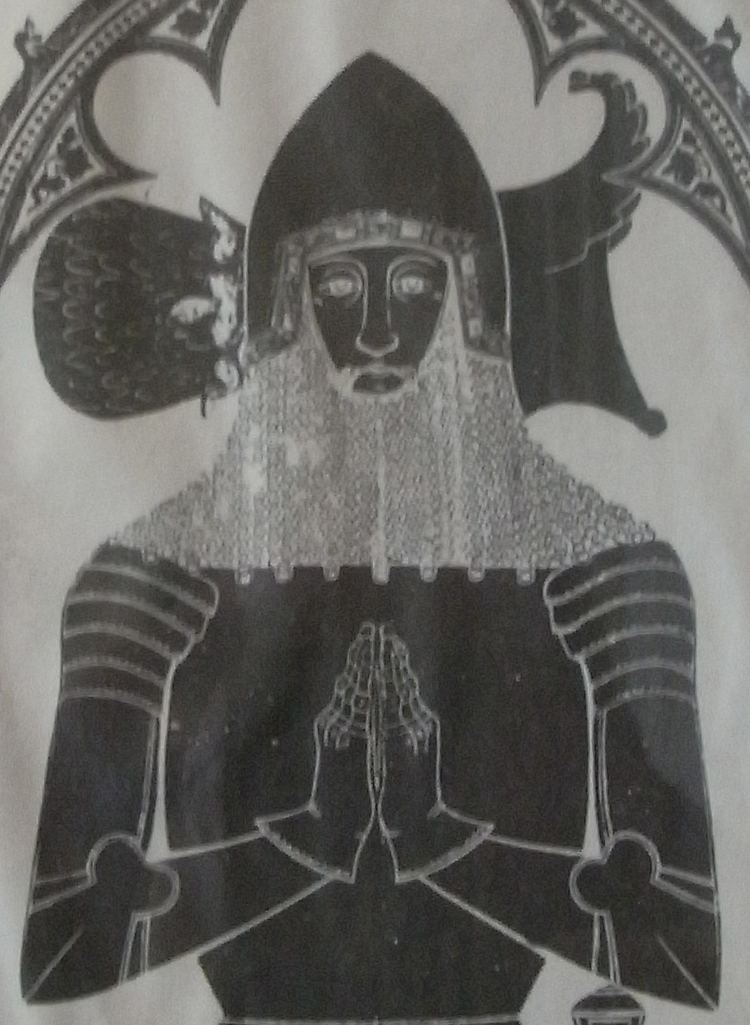Name Peter Courtenay | Role Died 1405 | |
 | ||
Sir Peter Courtenay, KG, (1346–1405) was a soldier, knight of the shire, Chamberlain to King Richard II (1377–1399) and a famous jouster. His principal seat was Hardington Mandeville, Somerset.
Contents
Origins
He was the 5th son of Hugh de Courtenay, 2nd Earl of Devon (1303–1377) by his wife Margaret de Bohun (d.1391). He had several highly prominent elder brothers, but was the most flamboyant of them all:
Career
He received the honour of knighthood from the Black Prince after the Battle of Najera in 1367, at the same time as his brother Sir Philip. In 1378 whilst on a naval expedition with his brother Sir Philip, under the command of Richard FitzAlan, 11th Earl of Arundel (d.1397) and William de Montacute, 2nd Earl of Salisbury (d.1397), the fleet was attacked by Spaniards off the coast of Brittany and Sir Peter and his brother were captured. His ransom was paid by two wealthy burgesses of Bristol.
Marriage
He married Margaret Clyvedon, daughter of John de Clyvedon by his wife Elizabeth.
Death and burial
He died on 2 February 1405 and was buried in Exeter Cathedral, where his monumental brass, much worn-away, exists set into a slab in the floor of the south aisle. It was reported by Lysons in 1822 as being then situated further to the west in or near the now demolished Courtenay chantry chapel, near to the chest tomb of his parents, which has also been moved. He is shown full-length, in armour, with hands together in prayer. The figure is very similar to those of Sir Maurice Russell (d.1416) in Dyrham Church, and to that of Thomas de Berkeley, 5th Baron Berkeley (d.1417) at Wotton-under-Edge, both in Gloucestershire. His figure is surrounded by a ledger line on which was formerly visible the following inscribed leonine verse (or "jingling verse") in Latin, transcribed by John Prince in his Worthies of Devon, with variants in brackets given by Polwhele:
"Devoniae natus, comitis (comes) Petrusque vocatus,
Regis cognatus, camerarius intitulatus,
Calisiae (Ecclesiae) gratus, capitaneus ense probatus,
Vitae privatus, fuit hinc super astra relatus,
Et quia (qua) sublatus, de mundo transit amatus,
Caelo (Coelo) firmatus (confirmatus), maneat sine fine beatus".
Which may be translated literally into English thus:
"Born of the Earl of Devon, called Peter,
A relation of the king with title "Chamberlain"
Beloved of Calais, a Captain proven by the sword
Deprived of life he was carried away hence above the stars
And where lifted up beloved he crossed from the world
Strengthened by Heaven may he remain blessed without end".
Poetic translations into English were made by Prince (d.1723), in his "Worthies of Devon" and in Richard Izacke's "Antiquities of Exeter". Prince's verse is thus:
"The Earl of Devonshire's son, Peter by name
Kin to the King, Lord Chamberlain of fame
Captain of Calais, for arms well approved
Who dying was above the stars removed
And well beloved went from the world away
To lead a blessed life in Heaven for aye
Similar leonine verse may be seen on the tombstone of English design of Robert Hallam (d.1416), Bishop of Salisbury, at Constance Cathedral, Germany, and on the brass of Sir Maurice Russell (d.1416) at Dyrham. The surviving chest tomb of Bishop of Exeter James Berkeley (d.1327) in the south ambulatory only a few feet away from Courtenay's brass, originally displayed similar verse including the line In Barkley natus, jacet hic Jacobus tumulatus ("In Berkeley (Castle) he was born, here lies James covered"), stripped away with his brass in 1561.
Above his figure and to the sides are four heraldic escutcheons showing his paternal arms of Courtenay and his maternal arms of Bohun. At the extreme top on either side within barbed quatrefoils is a figure of a hawk mantling over its captured prey of a duck (right) and a heron (left).
